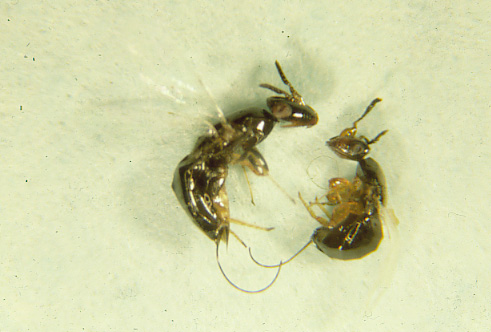 |
|
• People • Teaching • Links |
Fig wasp Research
Population structure and genetic diversity in fig wasps We have developed
an EST database for one species of Pegoscapus pollinator from Panama (Pegocapus
estherae, ex. Ficus costaricana), that we are using to develop
sequencing markers for population genetics and molecular evolution studies.
In particular, the extremely subdivided population structure of fig wasps,
and the ease of approximately estimating that structure without genetic
data, make fig pollinating wasps an ideal system for conducting studies
of the genetic consequences of evolution in subdivided populations. Population
genetic studies of mtDNA and nuclear variation in 11 fig wasp species
show a pattern consistent with the effects of directional selection (hithchiking)
or selection against linked deleterious mutations The effect of Wolbachia infection in fig wasps We have studied the dynamics of Wolbachia in fig wasp communities.
Wolbachia are alpha-proteobacteria that are found in a wide range
of arthropods and filarial nematodes, and that cause a diverse range of
important fitness-related phenotypic effects on their hosts. A variety
of strains of Wolbachia infect many species of Neotropical fig wasps.
The high frequencies of Wolbachia infections and the biology
of fig wasps allows unparalleled opportunities to address interconnected
questions concerning Wolbachia in natural populations: |
|
|
All contents copyright © 2009 Carlos Machado. All rights reserved. |
 We
take advantage of a solid background on the ecology and natural history
of fig wasps to ask relevant molecular evolution and population genetics
questions. Current interests include studying the genetic consequences
of evolution in subdivided populations, the extent of cospeciation between
Neotropical figs and their pollinators, the geographical context of speciation
and cospeciation in the mutualism, and the potential for genetic introgression
across different fig species due to pollinator host switches (see
We
take advantage of a solid background on the ecology and natural history
of fig wasps to ask relevant molecular evolution and population genetics
questions. Current interests include studying the genetic consequences
of evolution in subdivided populations, the extent of cospeciation between
Neotropical figs and their pollinators, the geographical context of speciation
and cospeciation in the mutualism, and the potential for genetic introgression
across different fig species due to pollinator host switches (see  (background
selection) acting on any region of the genome but affecting mitochondrial
and nuclear loci equally due to the effective linkage generated by the
extreme levels of inbreeding observed in these species. Additional analyses
that look at the frequency spectrum of segregating mutations suggest that
directional selection might be the most plausible mechanism responsible
for the observed pattern, thus suggesting the action of selective sweeps
with potential genome-wide consequences in fig wasps. We are interested
in determining how often selective sweeps occur in these species and whether
they are correlated with the level of population subdivision.
(background
selection) acting on any region of the genome but affecting mitochondrial
and nuclear loci equally due to the effective linkage generated by the
extreme levels of inbreeding observed in these species. Additional analyses
that look at the frequency spectrum of segregating mutations suggest that
directional selection might be the most plausible mechanism responsible
for the observed pattern, thus suggesting the action of selective sweeps
with potential genome-wide consequences in fig wasps. We are interested
in determining how often selective sweeps occur in these species and whether
they are correlated with the level of population subdivision.